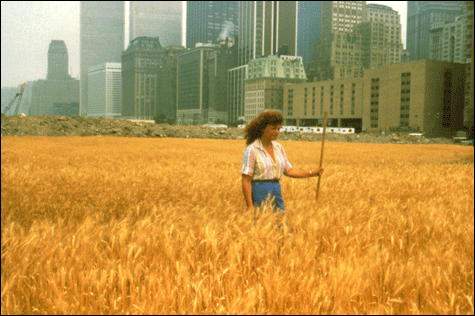“Green Horizons” at Bates College Museum of Art
By CHRIS THOMPSON | June 6, 2007

WHEATFIELD — A CONFRONTATION: by Agnes Denes, Battery Park Landfill, New York, 1982 |
On June 9, Bates College Museum of Art opens its “Green Horizons” exhibition — a six-month project, exploring the intersection of art, science, pedagogy, and the notions of sustainability and environmental engagement.
The show, including work by artists such as Alexis Rockman and Agnes Denes alongside local artists like Beehive Collective and Christina Bechstein, raises the stakes both for what an art institution might do to leverage its tools and its potential to produce impacts outside the world of art and visual culture, and for what a museum can do with its role at the intersection of academic community and civic life.
The Portland Phoenix caught up with Bates College Museum of Art director Mark Bessire to find out more about the “Green Horizons” project and its aims.
There’s such widespread debate concerning the term “sustainable” — what has the term come to mean for you?
It’s a quagmire, but an excellent point of departure to discuss the fate of our planet. The burden and worry will be if the discussion gets so political that the environment becomes a polarizing issue. If it does we will miss a great opportunity for bringing people together who may have very different opinions on other issues such Iraq and immigration but who are willing to come together to care for our planet. There is no question that the current generation of people of under 25 will take no prisoners on this issue; for our students, care for the planet is an essential part of a Bates experience.Architect Sim Van der Ryn has argued against letting “sustainability” be a resting place — instead he advocates a shift in thinking in the direction of what he calls “surpassability:” the design of systems, interactions, and structures that are forms of life, truly able to evolve, where the operative idea would not be efficiency or productivity but health. “Green Horizons” seems to work on this kind of scale.
This project is co-curated by a team including myself, Anthony Shostak and Bill Low. In order to tackle a project with so many commissions and new works we understood from the beginning that it had to be a more organic process and that we as museum “professionals” needed to secede our normal excessive control needs to the artists and the process. So in a way “surpassability” would be a good description. As a museum we are prepared for every visit to the museum to be different as the work changes and the site-specific works like Seitu Jones and professor Kim Ruffin’s collard green garden will literally grow as summer beckons. Part of our philosophy is to be less linear and controlling, so this exhibition was an excellent opportunity to challenge traditional museum control issues. It’s a big risk for us, but the potential returns are monumental for our audience as we become more of a laboratory than a mausoleum.
 Related
Related:
Retooled, Looking backward, Diamonds in the rough, More 
- Retooled
What follows is a response to the provocation posed by the Bates College Museum of Art’s current show “Activator,” a tightly organized exhibition of six installations by seven young artists
- Looking backward
Seems like it was a pretty good year.
- Diamonds in the rough
In 1941, 27-year-old Polish Jew Meyer Hack was deported to Auschwitz along with his mother, two sisters, and brother.
- Silent Theater: The Art of Edward Hopper by Walter Wells
Phaidon | 264 pages | $69.95
- A life in music
Why is that we install a stop light after an accident?
- Devil in the details
A small solo show of Andrea Sulzer’s drawings and woodcuts at the Bowdoin Museum of Art, entitled “After Nature,” is nothing short of riveting.
- Win tickets to Grizzly Bear
Text the word GRIZZLY to 22122*, and you will be entered into a random drawing to win yourself and a pal a pair of tickets to see Grizzly Bear on August 14 at the MFA.
- Three’s a charm
Muhly, Amidon, and Bartlett are all VT-to-NY transplants and long-time collaborators.
- A shadow world
The centerpiece of Lauren Fensterstock’s installation at the Bowdoin College Museum of Art is what appears to be a large black pool with giant lily pads.
- Review: ''Backstage Pass'' at the PMA
The half-century chronology covered by the Portland Museum of Art's latest exhibition, "Backstage Pass," reveals in photographic portraiture a story of music that is a euphemism for the ultimate creative act. Like sex, rock-and-roll is about surrender to the present moment.
- Forceful feelings
Auguste Rodin (1840-1917) was one of the greatest sculptors in history.
- Less

 Topics
Topics:
Museum And Gallery
, Cultural Institutions and Parks, Museums, Alexis Rockman, More  , Cultural Institutions and Parks, Museums, Alexis Rockman, Bates College Museum of Art Lewiston, Bates College Museum of Art, Christina Bechstein, Seitu Jones, Less
, Cultural Institutions and Parks, Museums, Alexis Rockman, Bates College Museum of Art Lewiston, Bates College Museum of Art, Christina Bechstein, Seitu Jones, Less 